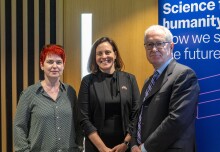

The Department of Chemical Engineering and the Department of Physics receive £300,000 in research funding <em> - News </em>
Thursday 6 March 2008
By Colin Smith
Gut bugs that can turn raw sewage into energy and the next generation of fibre-based lasers are amongst research projects recognised last week with Royal Society Awards aimed at supporting and encouraging innovation.
Professors David Stuckey and Andrew Livingston, from Imperial College Londonâs Department of Chemical Engineering, and Professor Roy Taylor, from the Department of Physics, received Brian Mercer Awards at the event on Thursday 28 February 2008.
The annual ceremony, organised by the Royal Society to help researchers commercialise their scientific ideas, saw Professor David Stuckey win the Brian Mercer Award for Innovation.
Professor Stuckey received the grant of £250,000 to develop a revolutionary new sewage treatment process which will use bacteria that primarily comes from the human lower intestine to breakdown effluent.
Professor David Stuckey
Current sewerage treatment technology, which uses oxygen to breakdown waste, is power intensive - using 5 per cent of all energy used in the UK - and produces thousands of tonnes of sludge which is difficult to dispose of. Professor Stuckey believes he has developed an environmentally sound system which actually creates energy and clean water, and reduces sludge by 90 per cent.
The new funding will help Professor Stuckey to build and pilot a new plant, known as a Submerged Anaerobic Membrane Bioreactor (SAMBR), which will be located alongside the Cambridge Treatment Plant.
His technology employs a revolutionary new technique which uses membranes to filter wastewater out for potential reuse, and bacteria that doesnât require oxygen to breakdown waste.
Professor Stuckey says his bioreactor could be of particular benefit in countries where water is scarce. He also believes it could be used on a miniaturised scale, for example to treat waste in blocks of flats or small urban communities.
âImagine a day when mini bioreactors, located under apartment buildings, are able to convert raw sewerage from flats into valuable methane gas for use in household heating, and treated water recycled back to flush toilets. Funds from my award will develop the worldâs first low waste bioreactor which has the potential to revolutionise the way we deal with effluent,â said Professor Stuckey.
Meanwhile, Professor Andrew Livingston received an award worth £25,000 to develop a commercial sized machine which has the potential to construct super durable membranes for industrial use.
Professor Andrew Livingston
Membranes are used in industry to separate gases and liquids. They help to remove impurities when refining substances like petrol, natural gas and pharmaceuticals. Membranes are made from a range of substances including structural ceramics and plastic films and have microscopic holes which help to separate materials. However, tougher reinforced membranes are required by the pharmaceutical and petrochemical industry to perform separation tasks that currently cannot be done.
Professor Livingstonâs has already developed the tough thin film membranes required on a small scale. He now plans to use his award to conceive, design and build a new machine, similar to a printing press, which is able to roll out these membranes at 20 to 50 metre lengths.
âWe are moving into uncharted territory because no one has ever built a machine like this before at an industrial level. Award funding will give my research the financial boost it needs to take it to a commercial level,â said Professor Livingston.
Professor Roy Taylor from the Department of Physics received his £25,000 Brian Mercer Feasibility Award to develop new compact, efficient and easy-to-use lasers based on fibre technology.
Fibre lasers have already replaced conventional laser systems in applications as diverse as medical imaging and a variety of sensors.
Professor Taylor and his colleagues in the Collegeâs Femtosecond Optics research group aim to use fibres based on different chemicals, including fluoride, to create new lasers which operate at many wavelengths simultaneously, from the ultraviolet to the near infrared. This makes them far more powerful and efficient than traditional laser systems which operate at one or two fixed wavelengths.
Professor Taylor says that his team hopes to create one laser that can do the work of lots of lasers. Commenting on receiving the award from the Royal Society, he said:
âI am absolutely delighted to win this award. Once again it gives recognition to the achievements of my small but very successful group. The Royal Society's support via this Brian Mercer Feasibility Award lets us take a route to trying new things that others may not support in areas that have potential in the commercial market place - a vital aspect of science that definitely should not be overlooked.â
The Royal Society is an independent academy promoting the natural and applied sciences. Founded in 1660, the Society has three roles, as the UK academy of science, as a learned Society, and as a funding agency. Up to 150 guests attended the event, which was held in the Wellcome Trust Lecture Hall and chaired by Sir Peter William, treasurer of the Royal Society.
Article text (excluding photos or graphics) available under an Attribution-NonCommercial-ShareAlike Creative Commons license.
Photos and graphics subject to third party copyright used with permission or © Imperial College London.





